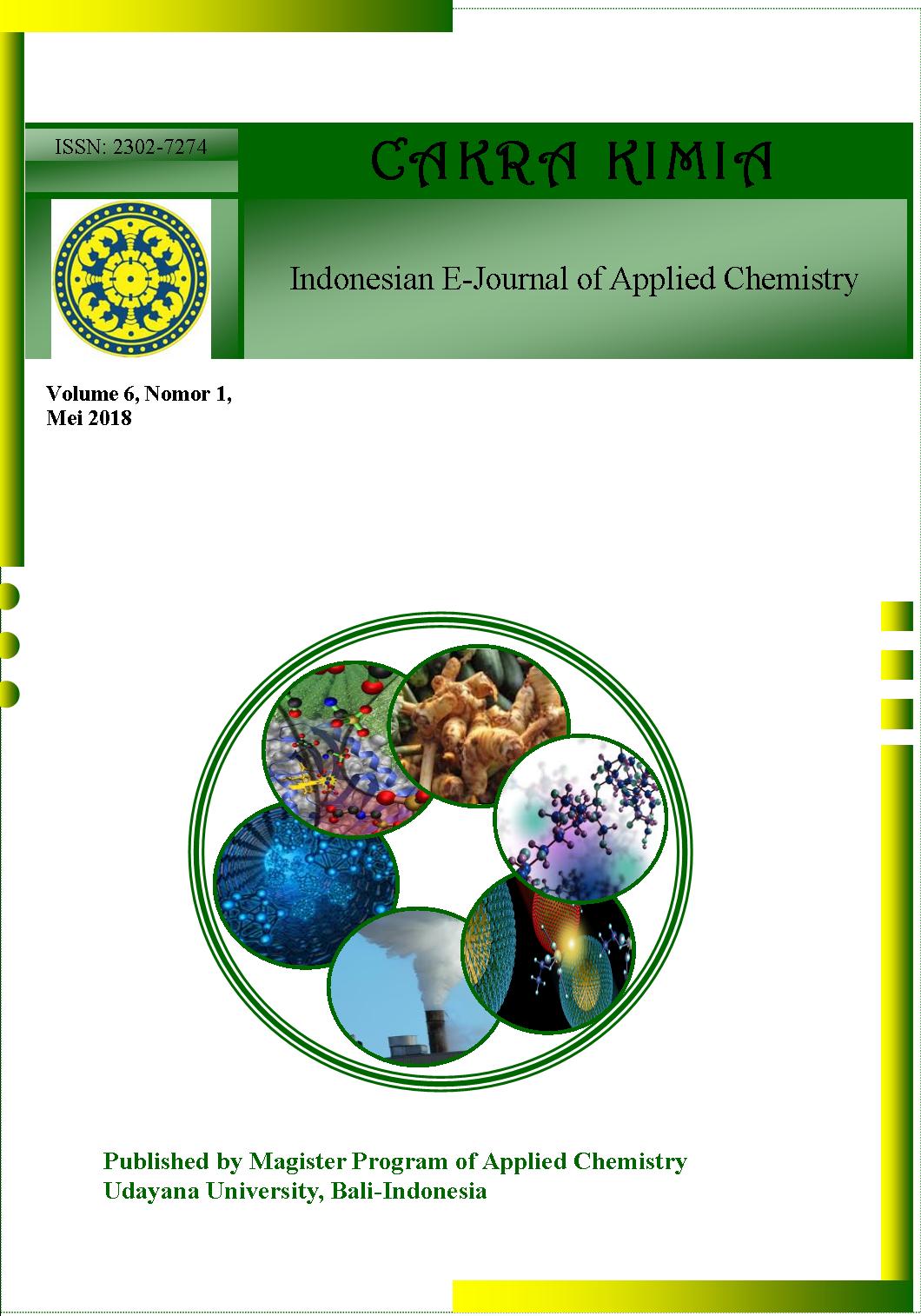REMOVAL KANDUNGAN TOKSIK LIMBAH PENCELUPAN MENGGUNAKAN NANO-SORBEN BERBASIS LIMBAH KERAJINAN TULANG SAPI
Abstract
ABSTRAK: Penelitian tentang removal kandungan toksik limbah pencelupan (organik sintetik toksik dan logam berat) menggunakan nano-sorben dari limbah kerajinan tulang sapi telah dilakukan. Tulang sapi dari limbah kerajinan diekstraksi untuk mendapatkan hidroksiapatit (HA) dengan karakteristik berpori, inert, ramah lingkungan, dan renewable. Selanjutnya HA tersebut disalut (coated) dengan oksida Fe dan oksida Fe-Al untuk membentuk HA bersitus aktif Fe dan Al kemudian dikarakterisasi dengan difraksi sinar-X (XRD) dan scanning electron microscopy (SEM). Adsorben berpori nano (nanopori-sorben) tersebut diaplikasikan untuk minimalisasi kandungan toksik limbah pencelupan. Optimasi waktu interaksi nanopori-sorben dengan limbah diperoleh dari interaksi antara nano-sorben dengan model limbah campuran methylene blue (MB) dan Cr(VI). Keberhasilan removal kandungan toksik limbah pencelupan ditentukan dengan memvariasikan volume limbah sebesar 15, 25, 35, dan 50 mL. Hasil penelitian menunjukkan bahwa oksida Fe dan oksida Fe-Al telah masuk ke dalam struktur kristalin HA dan telah membentuk lipatan-lipatan baru oleh oksida tersebut. Waktu optimum interaksi nano-sorben dengan limbah model campuran MB dan Cr(VI) adalah 15 menit. pH menurun dari 10,29 menjadi 8,31. Intensitas warna menurun dari absorbansi 0,0186 a.u menjadi 0,0000 a.u oleh nano-sorben HA-oksida Fe-Al dan HA-oksida Fe pada semua volume limbah, sedangkan nano-sorben HA belum mampu menurunkan intensitas warna pada volume limbah 35 dan 50 mL. Urutan kemampuan adsorpsi logam Cr dan kemampuan menurunkan COD berturut-turut adalah HA-oksida Fe-Al ? HA-oksida Fe ? HA. Penelitian ini menunjukkan bahwa HA tersalut oksida Fe dan oksida Fe-Al dapat menurunkan kandungan toksik limbah pencelupan optimum pada volume 35 mL.
Kata kunci: nano-sorben, tulang sapi tersalut oksida Fe-Al, hidroksiapatit, limbah pencelupan
ABSTRACT: A research of removal toxic content of dyes wastewater (toxic syntetic organic and heavy metals) by using nano-sorbent from waste of bovine bone handicraft has been carried out. The porous, inert, environmentally benign, and renewable material of hydroxyapatite (HA) was extracted from the bones. Further, the HA was coated with Fe oxide and Fe-Al oxide to form active sites of Fe and Al. The characterizations of the nanoporous sorbent of were carried out by X ray diffraction (XRD) and scanning electron microscopy (SEM). The nanoporous adsorbent was applied to minimaze the toxic content of dyes wastewater. Optimation of nano-sorbent contact time with wastewater was obtained by contacting the nano-sorbent with wastewater model of methylene blue (MB) and Cr(VI) mixture. A successful removal of dye wastewater toxic content was confirmed by varying the waterwaste volume of 15, 25, 35, and 50 mL. The characterization showed that Fe oxide and Fe-Al oxide were inserted into the hydroxiapatite crystal structure and form new coated layers. Optimum contact time of nano-sorbent with wastewater simulation of methylene blue (MB) and Cr(VI) mixture was 15 menit. pH decreased from 10.29 to 8.31. The colour intensity decreased from absorbance of 0.0186 a.u to 0,0000 a.u using nano-sorben HA-Fe-Al oxide and HA-Fe oxide in all volume variations. Whereas, the HA has yet to decrease on 35 and 50 mL. The adsorption capability upon Cr(VI) as follows: HA-Fe-Al oxide ? HA-Fe oxide ? HA. The lowest final COD after adsorption was obtained by HA-Fe-Al oxide ? HA-Fe oxide ? HA. We conclude that the Fe and Al oxide-coated HA could reduce dyes wastewater toxic content with optimum volume of 35 mL.
Downloads
References
[2] Wahl, D.A. and Czernuszka, J.T. 2006. Collagen-Hydroxyapatite Composites for Hard Tissue Repair. European Cell and Materials. Vol. 11. 43-56.
[3] Barakat, N.A.M., Khil, M.S., Omran, A.M., Sheikh, F.H. and Kim, H.Y. 2009. Extraction of Pure Natural Hydroxyapatite From The Bovine Bones Bio Waste by Three Different Methods. Journal of Materials Processing Technology. 209. 3408–3415.
[4] Simpen, IN., dan Suastuti, N.G.A.M.A., 2016. Modifikasi Limbah Tulang Sapi Bali dan Pemanfaatannya untuk Adsorpsi Methylene Blue. Jurnal Veteriner. Vol. 17. No. 4. pp. 597-606.
[5] Reichert, J. and Binner, J.G.P. 1996. An Evaluation of Hydroxyapatite-based Filters for Removel of Heavy Metal Ions from Aqueous Solutions. Journal of Materials Science. 31: 1231-1241.
[6] Fuqiang, L., Jinlong, C., Aimin, L., Zhenghao, F, Junjie, G. And Quanxing, Z. 2004. Equilibrium Adsorption of Single Component and Binary Mixtures of Aromatic Compound onto a Polyfunctional Hypercrosslinked Poltmeric Adsorbent. Journal of Adsorption Science and Technology. 22 (1). 13-24.
[7] Mahdy, T., Mohamed, G. and Elhawary, A. 2008. Effect Methylene Blue on Intra-abdominal Adhesion Formation in Rats. International Journal of Surgery. 6. 452-455.
[8] Adhi, N.G.A.S., Simpen, IN. dan Putra, A.A.B. 2017. Reduksi Komponen Toksik dari Limbah Cair Garmen Menggunakan Bio-Anorganik-Sorben Arang Tulang. Cakra Kimia (Indonesian E-Journal of Applied Chemistry). 5(1). 18-25.
[9] Satpathy, K. and Chaudhuri, M. 1997. Treatment of Cadmium-Plating and Cromium-Plating Wastes by Iron Oxide-Coated Sand, Environ. Sci. Technol. 31. 1452-1462.
[10] Simpen, IN. dan Adhi, N.G.A.M.D.S. 2015. Pengembangan Nano-sorben Berbasis Limbah Karajinan Tulang: Modifikasi, Karakterisasi dan Aplikasi Untuk Minimalisasi Kandungan Limbah Pencelupan dan Penyepuhan Krom. Laporan Akhir Penelitian Hibah Bersaing Tahun ke-1. Universitas Udayana. Denpasar.
[11] Babarinde, N.A.A., Oyesiku, O.O. and Dairo, O.F. 2007. Isoterm and Thermodynamic Studies of the Biosorption of Cooper (II) Ions by Erythrodontium barteri. International Journal of Physical Sciences. Vol. 2. (11). 300-304.
[12] Hong, S., Wen, C., He, J., Gan, F. and Ho, Y-H. 2009. Adsorption Thermodynamics of Methylene Blue onto Bentonite. Journal of Hazardous Materials. 167. 630-633.
[13] Kongsri, S., Janpradit, K., Buapa, K., Techawongstien, S., and Chanthai, S. 2013. Nanocrystalline Hydroxyapatite from Fish Scale Waste: Preparation, Characterization and Aplication for Selenium Adsorption in Aqueous Solution. Chemical Engineering Journal. 215-216. 522-532.
[14] Park, J.H., Lee, D-W., I.M., S-W., Lee, Y.H., Suh, D-J, Jun K-W., and Lee, K-Y. 2012. Oxidative coupling of methane using non-stochiometric lead hydroxyapatite catalyst mixtures. Fuel. 94. 433-439.
[15] Pujar, A.S., Yadawe, M.S., Pujeri, U.S., Hiremath, S.C., Balappanavar, V., Hiremath, S., Hiremath, V., Mathapati, S., and Hiremath, D. 2014. Determination of BOD, COD, DO and Other Pysico-Chemical Properties of Sugar and Cement Industries. Research Journal of Pharmaceutical, Biological and Chemical. 5(6). 1075-1078.



 Petunjuk Penulisan
Petunjuk Penulisan
